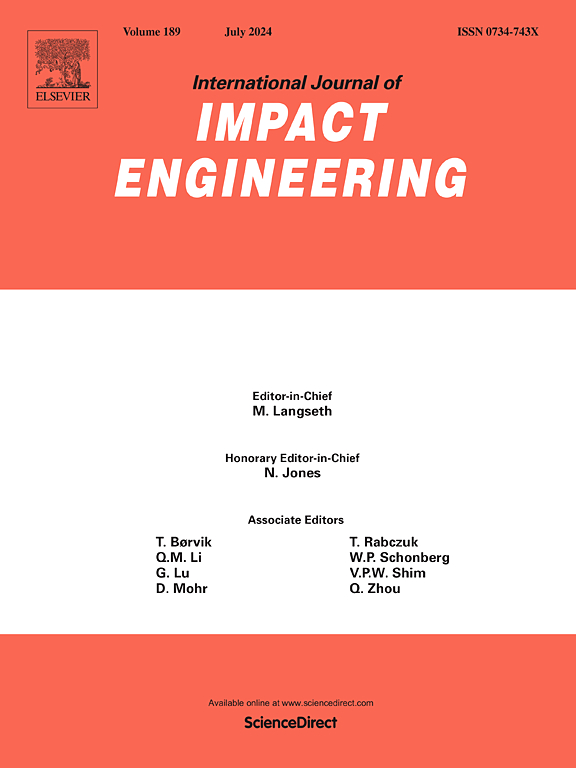Investigation on the spalling failure of concrete under high strain rate loading by simulation and experimental method
IF 5.1
2区 工程技术
Q1 ENGINEERING, MECHANICAL
International Journal of Impact Engineering
Pub Date : 2025-06-15
DOI:10.1016/j.ijimpeng.2025.105445
引用次数: 0
Abstract
This study investigates the dynamic tensile failure mechanisms, namely spalling, and strength evaluation of concrete under high-strain-rate loading. Spalling occurs during one-dimensional stress wave propagation when a reflected tensile pulse superposes with the incident compressive wave. Utilizing a modified split Hopkinson pressure bar (SHPB) combined with the digital image correlation (DIC) and finite element modeling (FEM), we analyze the spalling process. Results reveal three distinct failure phases: (1) compression-rebound, (2) tensile stress development, and (3) fracture. Spalling duration decreases inversely with impact velocity. Critical parameters—initial fracture velocity, maximum tensile strain, and strain rate—show minimal sensitivity to velocity variations within the tested ranges. Dynamic tensile strength, determined via free-surface velocity rebound and dynamic stress-strain relationships, yielded consistent results validated by FEM simulations. The dynamic increase factor (DIF) for tensile strength ranged from 3.20 to 3.39 at strain rates of 13.00 s⁻¹ to 14.41 s⁻¹. While the Karagozian and Case (K&C) constitutive model predicted first crack locations, its ability to simulate subsequent crack patterns was limited due to concrete's inherent mesoscopic and microscopic heterogeneity. The findings of this paper enhance the understanding of concrete's dynamic tensile response and provide a basis for designing protective structures against blast and impact loads.
高应变率荷载作用下混凝土剥落破坏的模拟与试验研究
本研究探讨了混凝土在高应变率荷载下的动态拉伸破坏机制,即剥落和强度评估。在一维应力波传播过程中,当反射的拉伸脉冲与入射的压缩波叠加时,会发生剥落。利用一种改进的霍普金森压杆(SHPB)方法,结合数字图像相关(DIC)和有限元建模(FEM),对其剥落过程进行了分析。结果显示了三个不同的破坏阶段:(1)压缩-回弹,(2)拉应力发展和(3)断裂。剥落持续时间与冲击速度成反比减小。关键参数——初始断裂速度、最大拉伸应变和应变速率——在测试范围内对速度变化的敏感性最小。动态抗拉强度由自由表面速度回弹和动态应力-应变关系确定,得到了FEM模拟验证的一致结果。拉伸强度的动态增加因子(DIF)在13.00 s⁻¹到14.41 s⁻¹的应变速率下从3.20到3.39不等。虽然Karagozian和Case (K&;C)本构模型预测了第一次裂缝的位置,但由于混凝土固有的细观和微观非均质性,其模拟后续裂缝模式的能力受到限制。本文的研究结果增强了对混凝土动态拉伸响应的认识,并为设计抗爆炸和冲击荷载的防护结构提供了依据。
本文章由计算机程序翻译,如有差异,请以英文原文为准。
求助全文
约1分钟内获得全文
求助全文
来源期刊

International Journal of Impact Engineering
工程技术-工程:机械
CiteScore
8.70
自引率
13.70%
发文量
241
审稿时长
52 days
期刊介绍:
The International Journal of Impact Engineering, established in 1983 publishes original research findings related to the response of structures, components and materials subjected to impact, blast and high-rate loading. Areas relevant to the journal encompass the following general topics and those associated with them:
-Behaviour and failure of structures and materials under impact and blast loading
-Systems for protection and absorption of impact and blast loading
-Terminal ballistics
-Dynamic behaviour and failure of materials including plasticity and fracture
-Stress waves
-Structural crashworthiness
-High-rate mechanical and forming processes
-Impact, blast and high-rate loading/measurement techniques and their applications
 求助内容:
求助内容: 应助结果提醒方式:
应助结果提醒方式:


